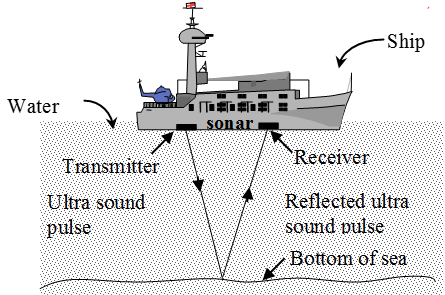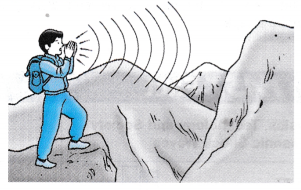What Is Echo
- The sound returning back towards the source after suffering reflection from a distance obstacle (a wall, a row of building etc.) is called an echo.
- When the sound is reflected repeatedly from a number of obstacles, more than one echoes, called multiple echoes are heard. Multiple echoes may be heard one after the other when sound gets repeatedly reflected from distant high rise buildings or hills. The rolling of thunder is an example of multiple echo formation.
- The two sounds–one direct and the other echo, can be heard distinctly provided the distance between the observer and the reflecting surface is large enough to allow the reflected sound to reach him without interfering with the direct sound. Since the sensation of sound persists for 1/10 second after it is produced, the echo can be heard distinctly only if it reaches at least 1/10 second after the original sound is produced.
Minimum distance between the observer and the obstacle for echo to be heard:
Let
Distance between the observer and the obstacle = d
Speed of sound (in the medium) = v
Time after which echo is heard = t
\( \text{Then, }t=\frac{2d}{v}\text{ or }d=\frac{vt}{2} \)
We know
Speed of sound in air at 25ºC = 343 ms-1
For an echo to be heard distinctly,
t ≥ 0.1 s
\( \text{Then, }d\ge \frac{343m{{s}^{-1}}\times 0.1s}{2} \)
or d ≥ 17.2 m
Thus, the minimum distance (in air at 25ºC) between the observer and the obstacle for the echo to be heard clearly should be 17.2 m.
The speed of sound increases with a rise in temperature. Therefore, the minimum distance in air between the observer and the obstacle for an echo to be heard clearly at temperatures higher than 25ºC is more than 17.2 m. In rooms having walls less than 17.2 m away from each other, no echo can be heard.
People also ask
- What is Sound and How is it Produced?
- What are the Different Types of Sound?
- Analysing Sound Waves
- What are the Characteristics of Sound Waves?
How does the sonar work?
The word ‘SONAR’ stands for Sound Navigation and Ranging.
(A) Principle of Sonar
Sonar is an apparatus which is used to find the depth of a sea or to locate the under water things like shoals of fish, enemy submarines etc. Sonar works by sending short bursts of ultrasonic sound from a ship down into sea water and then gets echo produced by the reflection of ultrasonic sound from under-water objects like bottom of sea, shoal of fish, a submarine.
(B) Working of Sonar

(i) A transmitter (for emitting ultrasonic waves) and (ii) a receiver (for detecting ultrasonic waves). Now suppose a sonar device is attached to the under-side of a ship and we want to measure the depth of sea (below the ship). To do this the transmitter of sonar is made to emit a pulse of ultrasonic sound with a very high frequency of about 50,000 hertz. This pulse of ultrasonic sound travels down in the sea-water towards the bottom of the sea. When the ultrasonic sound pulse strikes the bottom of the sea, it is reflected back to the ship in the form of an echo. This echo produces and electrical signal in the receiver part of the sonar device. The sonar device measures the time taken by the ultrasonic sound pulse to travel from the ship to the bottom of the sea and back to the ship. Half of this time gives the time taken by the ultrasonic to travel from the ship to the bottom of the sea.
d = Depth of sea
v = Velocity of sound in sea water
t = time recorded by the recorder
\(v=\frac{2d}{t}\)
Reason For Using Ultrasonic Waves In Sonar
- Ultrasonic waves have a very high frequency due to which they can penetrate deep in sea water without being absorbed.
- Ultra sonic waves cannot be confused with the noise, such as the voice of engines of ship. It is because the ultrasonic waves are not perceived by human ear.
Echo And Sonar Example Problems With Solutions
Example 1. A girl hears the echo of his own voice from a distance hill after 3 second. The speed of sound in air is 340 m/s. What is the distance of the hill from the girl ?
Solution: Let d be the distance of the hill from the girl. Total distance travelled by the sound in going and coming back = 2d
Now,
\( v=\frac{\text{Total}\,\text{distance}\,\text{travelled}}{\text{Time}\,\text{taken}}=\frac{\text{2d}}{\text{t}} \)
\( \Rightarrow 340=\frac{2\times d}{3} \)
⇒ d = 510 m
Example 2. The ultrasonic waves take 4 seconds to travel from the ship to the bottom of the sea and back to the ship. What is the depth of the sea ? (Speed of sound in water = 1500 m/s.)
Solution: The time taken by the ultrasonic sound waves to travel from the ship to the sea-bed and back to the ship is 4 seconds. So, the time taken by the ultrasonic sound to travel from the ship to sea-bed will be half of this time, which is 4/2 = 2 seconds. This means that the sound takes 2 seconds to travel from the ship to the bottom of the sea
\( \text{Now, Speed}=\frac{\text{distance}}{\text{Time}} \)
\( 1500=\frac{\text{Distance}}{2} \)
And, Distance = 1500 × 2m = 3000m
Example 3. A submarine emits a sonar pulse which returns from the underwater cliff in 1.02 s. If the speed of sound in salt water is 1531 ms-1, how far away is the cliff ?
Solution: Given: Speed of sonar pulse, V = 1531 ms-1, Time interval of return journey of the pulse,
t = 1.02s
Let the distance of the underwater cliff be S.
For distance S of the cliff, the pulse travels a total distance of 2S in return journey.
From relation, distance = speed × time
2S = vt
\( \text{We have, }S=\frac{vt}{2} \)
\( S=\frac{1531m{{s}^{-1}}\times 1.02s}{2} \)
S = 780.8 m
Example 4. An ultrasonic ruler is used to determine the depth of a seabed. A pulse of sound is generated and travels to the seabed before reflecting back. The time taken by the pulse to travel to the seabed and back is 0.28 seconds. If the speed of sound in the water is 1500 m s-1, calculate the depth of the seabed.
Solution:
Let the depth of the seabed be h m.
The distance travelled by the pulse to the seabed and back = 2h m
2h = v x t
= 1500 x 0.28 = 420 m
Therefore, h = 210 m
Hence, the depth of the seabed is 210 m.
Example 5. A boy shouts towards a mountain and hears his echo 4.5 seconds later.

If the mountain is 765 m from the boy, calculate the speed of sound in air.
Solution:
Let the speed of sound in air be v m s-1.
The distance travelled by the sound to the mountain and back = 2d
2d = 2 x 765
= 1530 m
2d = v x t
1530 = v x 4.5
Therefore,
v = 1530/4.5
= 340 m s-1
Hence, the speed of sound in air is 340 m s-1.
Example 6. A radar transmits a signal towards an aeroplane. The velocity of the signal is 3.0 x 108 m s-1. After 3.6 x 10-3 s, the radar detects the reflected signal. What is the distance of the aeroplane from the radar?
Solution: 2d = v x t
= 3.0 x 108 x 3.6 x 10-3
= 1.08 x 106 m
Therefore,
d= 5.4 x 105 m